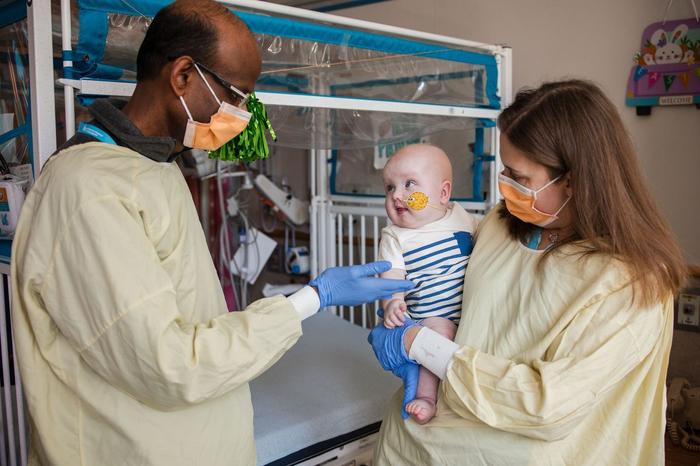In a landmark advancement poised to redefine the landscape of precision medicine, researchers at the Children’s Hospital of Philadelphia (CHOP) in collaboration with Penn Medicine have achieved a groundbreaking milestone in treating a rare metabolic disorder using bespoke CRISPR-based gene editing therapy. This pioneering intervention involved an infant named KJ, diagnosed with severe carbamoyl phosphate synthetase 1 (CPS1) deficiency, a life-threatening urea cycle disorder that disrupts the body’s essential ability to detoxify ammonia. The team’s success represents the first-ever in vivo application of a patient-specific CRISPR gene editing treatment designed and administered within months of birth, signaling a transformative era in individualized therapeutic strategies.
CRISPR gene editing technology, leveraging clustered regularly interspaced short palindromic repeats and associated nucleases, offers unparalleled precision in targeting and modifying specific DNA sequences. Yet, the diversity of pathogenic variants seen across rare genetic disorders has historically impeded generalizable treatments, demanding tailored solutions adapted to individual genomes. Ahrens-Nicklas and Musunuru, leading scientists in gene therapy and molecular therapeutics, embarked on an ambitious collaboration in 2023, focusing on the feasibility of creating patient-specific interventions tailored for ultra-rare conditions like urea cycle disorders. Their work harnessed advances in somatic cell genome editing, propelled by NIH-funded consortia, enabling the design, manufacture, and delivery of a bespoke base editing construct within a remarkably compressed timeline.
The therapeutic mechanism employed lipid nanoparticle delivery systems to ferry the gene editing complex directly to hepatocytes, the metabolic factory within the liver responsible for ammonia detoxification. Using an adenine base editor optimized to convert the defective adenosine residue within CPS1’s genomic locus, the team achieved in vivo correction of the disease-causing variant. Unlike traditional double-strand break-inducing CRISPR systems, base editing offers a subtler and potentially safer approach by directly converting single nucleotides without creating DNA strand breaks, thus reducing risks linked to off-target mutagenesis and unwanted genomic rearrangements. This precision was paramount for infant patients whose developing tissues require utmost genomic integrity.
The rapid translation of gene editing technology from bench to bedside underscores the power of interdisciplinary collaboration and technological convergence. By combining in-depth genetic analysis, advanced molecular engineering, and innovative delivery platforms, the team demonstrated that therapeutics need not be constrained by the rarity or uniqueness of a patient’s genetic anomaly. This “one-patient-at-a-time” approach challenges traditional drug development paradigms, offering a blueprint for treating rare and ultra-rare diseases with individually tailored modalities, potentially addressing millions globally underserved by conventional pharmaceuticals.
Beyond the immediate clinical implications, this success story propels forward the ethical and regulatory frameworks necessary to accommodate personalized gene editing therapies. The accelerated timelines and bespoke manufacturing processes necessitate agile oversight balancing patient safety with the imperative for timely intervention, especially in pediatric populations with progressive and fatal conditions. Moreover, long-term monitoring remains essential to elucidate durability, sustained efficacy, and any delayed adverse events inherent to genome editing techniques, thereby informing the broader clinical application and ensuring responsible implementation.
The team envisions expanding this methodology to encompass a broader array of inherited metabolic and genetic disorders, many of which currently lack effective therapies due to genetic heterogeneity. By leveraging the modularity of base editors and delivery systems, researchers anticipate the ability to customize therapies rapidly for diverse pathogenic mutations across varied patient populations, thereby democratizing access to cutting-edge genomic medicine. This innovative paradigm shifts the focus from treating diseases as broad categories to focusing intently on the unique molecular etiology within each patient.
Parent testimonies poignantly illustrate the real-world impact of this intervention. KJ’s parents describe an arduous journey marked by hospital stays, dietary restrictions, and uncertainty, now transformed by the hope anchored in gene editing therapy. Their willingness to embrace the novel treatment highlights the essential partnership between clinicians, researchers, and families in navigating uncharted therapeutic territory. This collaboration embodies the spirit of translational medicine, where scientific breakthroughs tangibly translate into improved patient lives.
The study, published in the New England Journal of Medicine and unveiled at the American Society of Gene & Cell Therapy Annual Meeting in New Orleans, represents a seminal contribution to the field. Funding support from the National Institutes of Health’s Somatic Cell Genome Editing Program and collaborative in-kind contributions from biotechnology firms underscored the multi-sectoral endeavor driving these advancements. Such integration of academic research, clinical expertise, and industry innovation forms the backbone of modern therapeutic development, accelerating the path toward highly effective treatments for rare genetic diseases.
While this initial case focuses on CPS1 deficiency, the broader implications extend across the spectrum of genetic medicine. The capacity to engineer and deliver bespoke gene editing tools on an accelerated timeline promises to address scattered or unique pathogenic variants previously deemed untreatable. As gene therapy technology matures and delivery platforms refine, the vision of precision genomic medicine as a primary modality in pediatric and adult care becomes increasingly tangible, heralding a future where genetic diseases can be corrected directly at their source.
In sum, this pioneering work with KJ exemplifies the convergence of cutting-edge molecular biology, clinical acumen, and patient-centered innovation. It embodies a new frontier where the promise of CRISPR gene editing moves beyond experimental potential into real-world efficacy, offering hope to millions affected by rare disorders. As follow-up studies extend and refine this approach, the medical community stands on the cusp of a transformative epoch in treating inherited diseases, one patient at a time.
Subject of Research: People
Article Title: Patient-Specific In Vivo Gene Editing to Treat a Rare Genetic Disease
News Publication Date: 15-May-2025
Web References:
https://www.chop.edu/
https://www.pennmedicine.org/
http://www.nejm.org/doi/full/10.1056/NEJMoa2504747
https://www.asgct.org/
References:
Musunuru et al., “Patient-Specific In Vivo Gene Editing to Treat a Rare Genetic Disease.” New England Journal of Medicine. Online May 15, 2025. DOI: 10.1056/NEJMoa2504747.
Image Credits: Children’s Hospital of Philadelphia
Keywords:
Gene editing, Gene therapy, Metabolic disorders, Inborn errors of metabolism, Pediatrics
Tags: bespoke medical interventions for infantsChildren’s Hospital of Philadelphia advancementsCPS1 deficiency treatmentCRISPR gene editing therapyin vivo gene editing applicationsindividualized therapeutic strategiesinnovative metabolic disorder therapieslipid nanoparticles in gene therapypersonalized medicine for genetic disordersprecision medicine breakthroughs 2023transformative healthcare innovationsurea cycle disorder management





